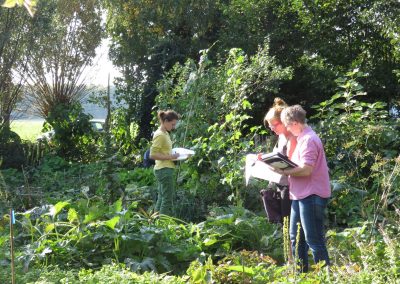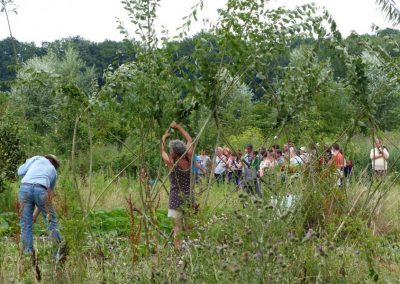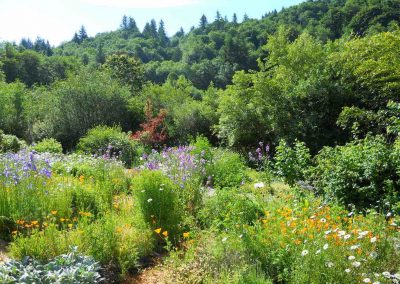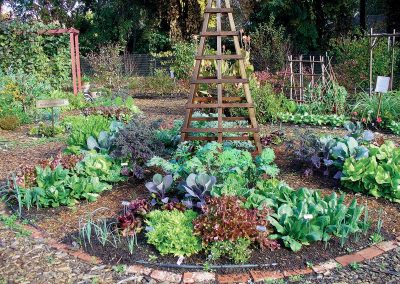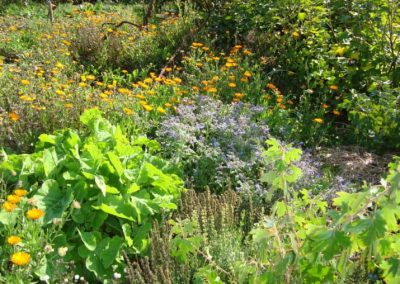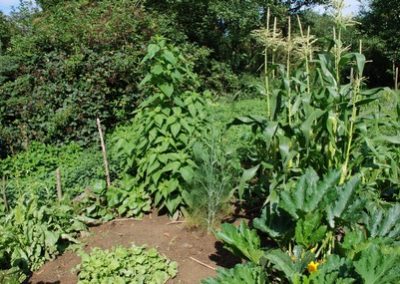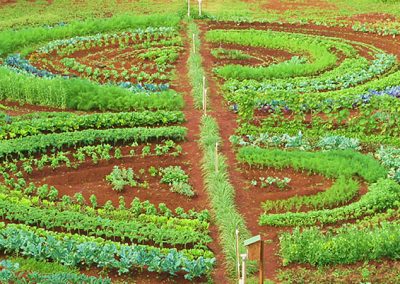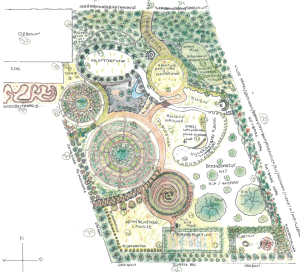Permaculture

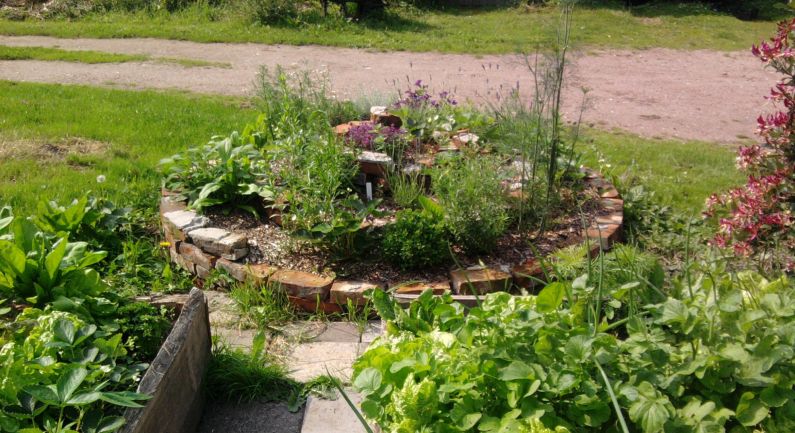
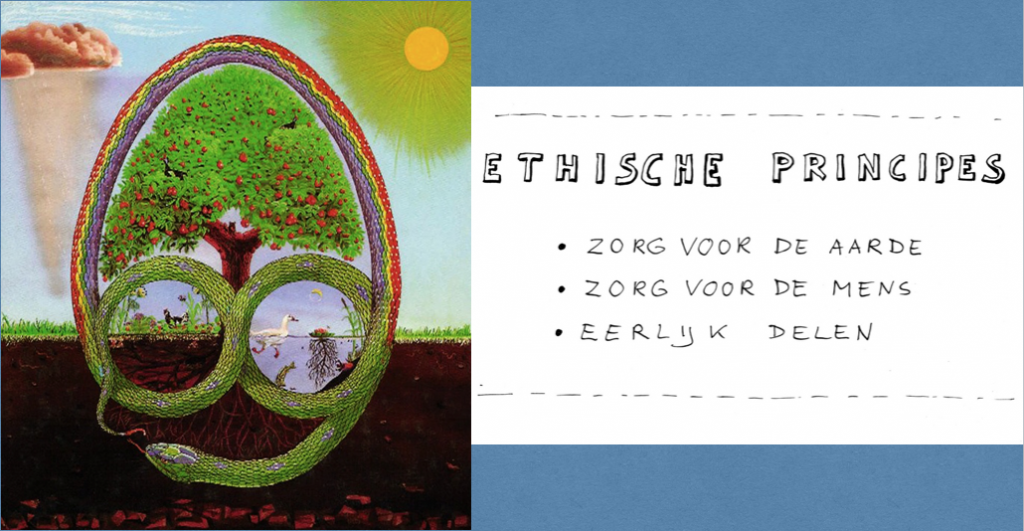
What is permaculture?
Permaculture is a science for designing the human environment in a way that is environmentally sustainable and economically stable. Complex ecosystems in nature serve as an example. Permaculture is sustainable circular and ecological thinking and acting. (Permaculture Wikipedia)
Permaculture has 12 principles. These principles are mainly made for a better cooperation with our nature, but can also be applied to organizations.
Permaculture principle 1 - Observe and act on it
Before you make a design, you observe the circumstances. In the case of a permaculture garden, one looks at the effect on the environment of the sun and shade, the wind, the water, but also of the flora and fauna. What is the temperature and humidity, has the land been affected by man, what was it like in the past? Which patterns do people recognize and how do you deal with them? With permaculture you can collaborate with the land in such a way that you and nature benefit from it. You can divide the land in such a way that it also has water during dry periods or remains drier during wet periods. Or use certain shrubs to ‘deceive’ game grazers. Ducks are handy too, they like to eat snails and snails like to eat your vegetables, buy a few ducks and the problem is solved naturally.
Permaculture principle 2 - Capture and store Energy
Solar panels and wind turbines are good examples of energy storage. Yet there are better ways such as storing energy by using gravity, (bio-)mass, color, and kenetic energy. For example, you can store heat energy in a stone and use that heat to accelerate the growth of plants or to warm up the temperature in an environment. Black also retains heat. Gravity can be used well when there is a difference in height, we know a hydrodam, but it is not easy to apply in the Netherlands, but you can place your rain barrel a little higher for water pressure to spray your garden. Or put a milk carton with holes in the ground and top it up every now and then. This promotes reuse and saves polluting products that should have been used differently. Wood is also a form of energy storage. Wood can be burned, but also used for compost and mushroom cultivation. These are all forms of energy conversion. Then there is ground heat and energy from bees stored in honey. By using local energy, the ecological impact is greater.
Permaculture principle 3 - Provide yield
Aesthetic, economic, societal, social and of course natural yield. Nature gives us everything and if you work together there is everything that the heart desires. Our hearts and those of nature. A landscape can be used for the health of nature and our nature through diversity, good layout, social events and hard work. Healthy local food, a beautiful environment that is in balance, flora for fauna and fauna for flora.
Permaculture principle 4 - Use self-regulation and accept feedback
“Regulate yourself and accept feedback” may be one that is often a bit inconvenient and even forgotten. Facing failures and areas for improvement is not easy, but that’s how you learn and grow. That is why I wrote here: ‘Learn from your mistakes’, but also the words ‘modesty’ (modesty) and ‘live simply’ (live simply). Because our society, with over-consumption, non-renewable raw materials and polluting emissions, ensures that we cannot continue living like this. The earth cannot sustain the number of people in this way (as in: providing food, water and other necessities) and we are only making it worse. So the idea of this principle is also that we look at ourselves and limit our own consumption and emissions as much as possible, or find other ways to supply them sustainably.
Permaculture principle 5 - Use and value renewable raw materials and services
I can’t really see this and the next point as separate. Andrew Millison said it so dryly: “A horse can do something a tractor can’t. A horse can make new horses, but have you ever seen a small baby tractor?” (a horse can do something a tractor can’t; a horse can make new horses, but have you ever seen a little baby tractor?). The point is, a horse and a tractor can both plow a field, but only the horse can regenerate. While a lot of stuff we use, like that tractor, ends up being soiled and broken. Parts can still be recovered, but at most recycled, usually not reused to make the same product with the same quality again.
You can avoid waste in several ways, in order of usefulness: reuse, repair (hence the T-shirt in the drawing, I don’t know if you can see it correctly but there is a hole in it that is being repaired), renew and recycle /upcycle. Renewing is preferable to recycling because with recycling you use the product for something else, usually lower quality, such as old plastic bottles or tires to make a wall. Renewal, on the other hand, is that you put the product back into the cycle to make the same or a similar product with the same quality. But renewing used items still takes energy. And that is why permaculture chooses organic substances over inorganic ones (such as plastic): the energy to break them down and reprocess them into high-quality raw materials is resisted by all kinds of cleaners and soil organisms, which in the meantime benefits biodiversity. The closer you get to it, the less energy is then used in transport (this also applies in your own garden: for example, it takes more energy to take something to the compost heap than to mulch with it and have it composted). Fast-growing wood (an alder that you prune back to a stump every few years, for example): it grows quickly, when it breaks down it releases nutrients and by the time it needs to be replaced you can harvest new ones. So: as many local resources and services as possible. And also: transition. We are all looking for a way and always learning, it is not expected that someone will suddenly be 100% sustainable.
Permaculture principle 6 - Don't produce waste, create cycles
Waste may disappear from sight, but not from our lives. Try to reuse and repair as much as you can and if you can’t handle it, you may need to consider whether you really need it or if you can replace it with something else. And: ‘Don’t waste people!’ Which means that you use people according to their abilities and passions, instead of letting them do work that ignores their assets and ruins their sense of it. I can speak from experience when I say that in the latter case their work yields much less and they cannot be deployed for a long time.
Permaculture principle 7 - Design of (natural) patterns to detail
The patterns, the movements about the location that you have seen during your observations, can then be worked out into a design (hence design from patterns to details). A sector compass shows from which sides elements enter the site and where you will have to place structures if you want to do something with them, such as capturing wind by placing a hedge. You can map people’s movements to see how their interaction with the site is now and how you could adjust it. This also includes the philosophy that certain shapes keep recurring in nature, because that pattern is the most efficient for a certain purpose and that you can use it to get the same thing done in your own design. Like in a swinging stream, the water accelerates and slows down, so that it deposits sediment in places and removes it in others. You can then use that shape for a path where you want to slow people down so that they look around, or to make them go faster or slower through the garden in certain places.
Permaculture Principle 8 - Unite rather than separate
More mutual relationships prevents something from not working or breaking down, so that we have to step in. It makes the entire permaculture system more resilient and flexible. Like water with fish nutrient-rich watering and fertilizing a field at the same time, as I’ve tried to draw here. It is often said that every function is carried by at least three elements and every element has at least three functions. I tried to draw a mini-version of this (it was fiddly, sorry). The first function here is: collecting (rain)water. The elements that do that are a tree that slows it down, young plants that absorb it, and mulch that holds it in. Each of those elements has a few functions: the mulch nourishes the young plants, tree and is a shelter for insects; the young plants provide food for humans, produce mulch and attract insects, the tree does the same but also produces (in this case) a medical remedy, for example (because I was thinking of linden when I drew this). And so on, and so on, and so on, and so on…
Permaculture principle 9 - Use small and slow solutions
Transitions between different landscape types and elements contain types of both and are therefore very diverse. More fringe means more microclimates and more diversity. This is how this stream oscillates, so it has a longer bank than if it were moving straight through the landscape. Other plants grow in coves than on bulges along the side. If this were a forest, it would be a little more open along this water, allowing more light to enter here and for other species to grow well than deeper between the trees. ‘Edge’ is therefore very valuable and permaculture strives for more edges with more diversity. The same goes for hedges and fences: don’t let them be ‘dead’ or inanimate objects without any interaction, but use them to grow edible plants or to increase biodiversity or – better of course – both. Use the space we already have an influence on, which is no longer natural and which can be found all around us, especially in the city, for a ‘yield’.
Permaculture Principle 10 - Use and Value Diversity
‘Use and value diversity’ applies to everything. An important aspect of permaculture is protecting and restoring natural, biodiverse ecosystems and making our human environment rich and productive (that ‘yield’ that also applies to animal species and the like!). Diversity in food supply makes our food more nutritious overall, ensures that everything is not ripe at once (with the risk of rotting), provides more habitat for different animals and reduces the risk of pests, diseases and crop failure due to bad and changing weather conditions. Diversity also applies to people and knowledge: we are all different, we all have a different way of looking and different skills; we can use that instead of telling each other that only we understand everything. In permaculture you often see that scientifically and intuitively minded and people with different experiences come face to face with each other. But together they form knowledge and come to new insights, which is why I wrote here: science – observation – experience. We all need it.
Permaculture principle 11 - Use edges and value the marginal
Living on the edge! The edge is where it happened. Your own skin is an example of this, but also the edge of the earth, where the fertile layer is located. Exchange occurs on the border between two cultures and the banks of a river provide space for land and water life. In our designs, therefore, we prefer to see a boundary as a possibility rather than a limitation. Where two ecosystems overlap, there is naturally more diversity. The edge of the forest has more diversity than the center of the forest. The edge of a path or road often shows more biodiversity than the path itself or its surroundings.
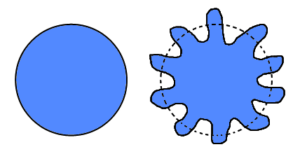
Permaculture principle 12 - Respond appropriately to changes and use them in a creative ecological way
“The biggest limit to abundance is lack of creativity,” as Toby Hemenway says. Permaculture is about that every situation is different (hence the observation) and that you have to respond to it differently. Respond to changes, ‘problems’ and mistakes, use them to your advantage. The problem is the solution (the problem is the solution – Bill Mollison): Understanding why the problem occurs gives you insight into what the solution might be. The climate is changing, try to take it into account and build on the future, however uncertain it may be (‘Adept to the future’). Rather small solutions than one big one.
Summarized in the words of Bill Mollison: “When we design, we’re always building for future floods, future fires, future drafts. And planting a tree, a few inches tall, that will be future forest giants, cast future shadows. Future populations will need future forest resources, shelter, security. So somebody needs to range ahead of time, scout out the next century. We are not daydreaming, we are time scouts, finding places now, for what will be needed then.” I hope everyone can follow this, because it’s quite a bit to translate, but if not, let me know in the comments and I’ll translate it anyway. But this beautiful quote summarizes all 12 principles. And this is what makes permaculture different.
Phew, that was quite a story, also to type. But for those who like to see the overview, like me, here’s the whole thing ;-):

